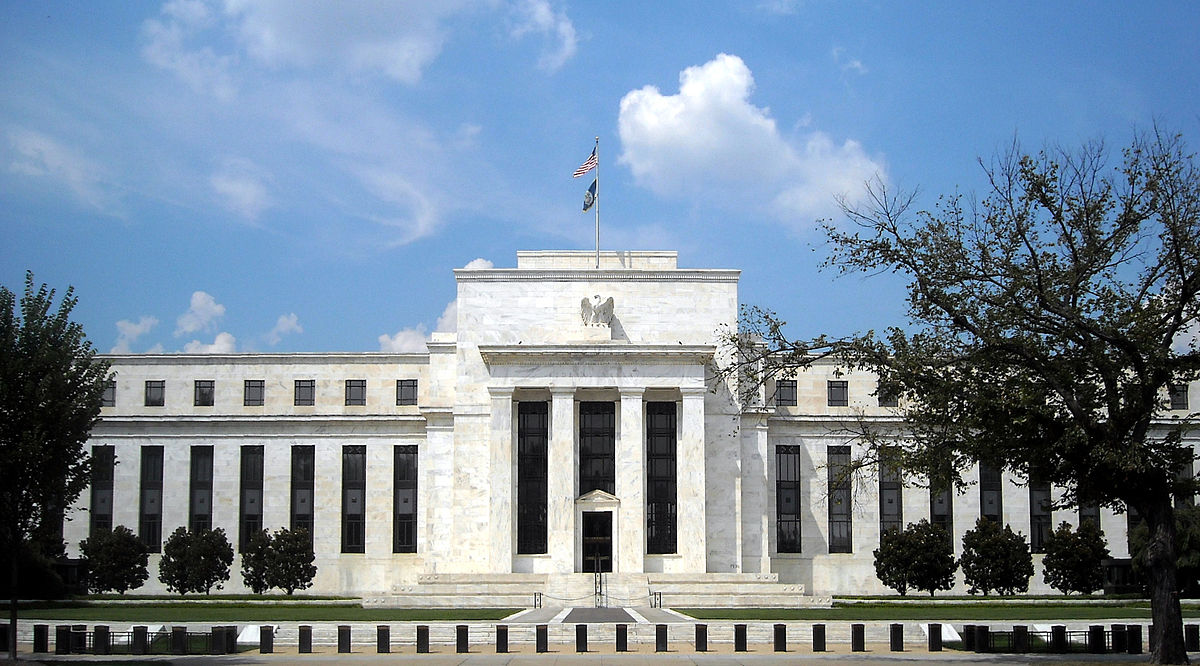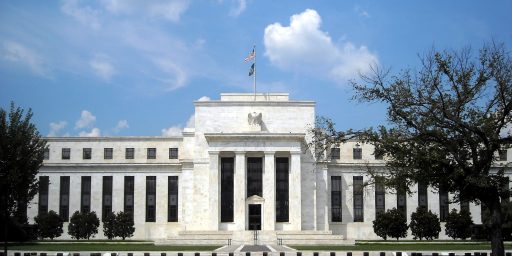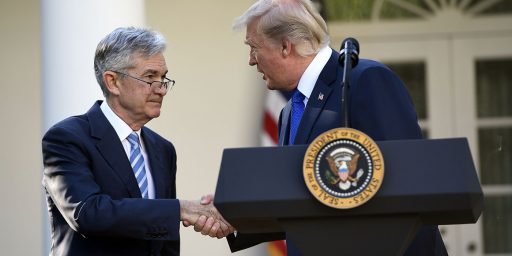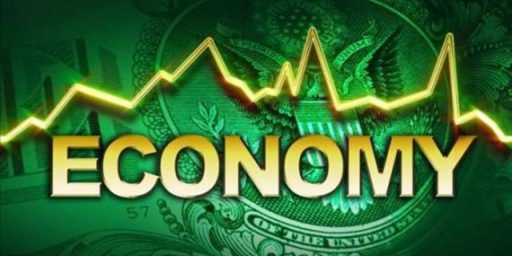Federal Reserve Cuts Rates Amid Signs Of Slowing Global Economy
WIth some signs pointing to a slowing global economy, and President Trump applying political pressure, the Federal Reserve reversed interest rate policy yesterday.

As had been expected, the Federal Reserve concluded its two-day July meeting with an announcement that it was cutting its core interest rate by a quarter percent, thereby reversing a policy of gradually raising rates that had been in place for the past several years:
WASHINGTON — The Federal Reserve cut interest rates on Wednesday for the first time in more than a decade, as it tried to keep America’s record-long economic expansion going by insulating the economy from mounting global risks.
The widely expected quarter-point decrease was the Fed’s first since it slashed rates to near zero in 2008. But unlike those cuts, which were intended to rescue a failing economy, Wednesday’s move was seen as a precautionary effort to protect the United States from slowing growth in China and Europe and uncertainty over President Trump’s trade war.
“The outlook for the U.S. economy remains favorable, and this action is designed to support that outlook,” the Fed chair, Jerome H. Powell, said at a news conference after the decision. The cut, Mr. Powell said, was “intended to ensure against downside risks from weak global growth and trade tensions.”
It was a turning point, but one that disappointed both markets and Mr. Trump, who were hoping for a bigger rate cut. The Fed, which dropped its target rate to a range of 2 percent to 2.25 percent, stopped short of signaling the beginning of an aggressive rate-cutting campaign. By the end of the day, the S&P 500 was down 1.1 percent, the benchmark index’s worst decline since May 31.
The Fed suggested its move was a small adjustment meant to help the economy weather uncertainty. While Mr. Powell left the door open to additional cuts, he said officials did not expect this to turn into the sort of deep cutting cycle that the Fed has done in the past to avert or offset recessions.
“It’s not the beginning of a long series of rate cuts — I didn’t say it’s just one,” Mr. Powell said. “What we’re seeing is that it’s appropriate to adjust policy to a somewhat more accommodative stance over time, and that’s how we’re looking at it.”
Not every Fed official agreed with cutting rates at a moment when the economy continues to grow, unemployment is at a 50-year low and wages are beginning to rise. Both Eric Rosengren, the president of the Federal Reserve Bank of Boston, and Esther George, the president of the Federal Reserve Bank of Kansas City, voted against Wednesday’s decision, preferring instead to leave rates unchanged. Those were the second and third dissents of Mr. Powell’s term as chair.
Officials also announced an early end to their efforts to shrink the Fed’s balance sheet, another attempt to keep the economy moving. The central bank’s holdings of government-backed bonds swelled during the financial crisis as the Fed bought assets to try to reinvigorate growth. Policymakers have been siphoning off securities to return the balance sheet to a more normal size, and that process — known as quantitative tightening — was scheduled to end after September. It will now conclude on Thursday.
As The Washington Post notes, the Federal Reserve’s interest rate cut was somewhat less than what Wall Street was hoping for not so much in terms of how much it was cutting rates but due to the fact that it didn’t make clear if this was a new policy going forward or a one-off decision that could be reversed depending on what future economic data, such as the Jobs Report that will be released tomorrow morning, might tell us about the course of the economy. As a result, the markets failed to react as positively as might have been expected, with markets ending the day mostly flat.
Also unclear is whether this will be enough to quell the criticism that has been coming from the White House, where President Trump has engaged in a rather unprecedented rhetorical war against his own Federal Reserve Board Chairman, blaming the Fed for the fact that the economy isn’t doing much better than it did during President Obama’s second term while ignoring the impact of his own policies, such as an ill-advised, economically stupid trade war that Fed Chairman Powell has cited as among the Fed’s chief concerns for the future of the economy. Indeed, even after the Fed announced its interest rate cut, the President continued his attacks, saying that cut was not substantial enough. This indicates that the President’s attacks on the ostensibly independent body are likely to continue and get worse as time goes on.
As Neil Irwin at The New York Times explains, the Fed’s decision to cut rates yesterday was basically an admission that it raised rates too rapidly:
The quarter-percentage-point cut to the target interest rate is really about trying to apply the lessons that the last decade have taught us. It is not a recession-fighting measure per se, but a recalibration, and an implicit acknowledgment that the Fed made a mistake last year by raising interest rates to nearly 2.5 percent.
In particular, the Fed in 2018 was overly confident that it could apply pre-2008 rules of thumb about what constitutes “normal” policy, what causes inflation, and how the Fed’s actions are likely to reverberate around the world. Wednesday’s action was about trying to undo that damage.
The action telegraphs that the Fed is willing to act to keep the economy on its growth path even in the absence of decisive evidence that the economy is slowing, which bodes well for the decade-long expansion to continue through next year’s presidential election and beyond.
But most important, it signals the death knell of an approach to setting monetary policy. The central bank had been slow to adjust to years of low growth, low inflation and international blowback whenever it moved to tighten the money supply.
An episode in late 2015 was one such example. The Fed was making plans to begin raising interest rates — to “normalize” them, as its officials often said, believing that the United States job market was returning to full health, and that there would be an outbreak of inflation if it didn’t act.
But the shift toward tighter policy contributed to a rising dollar and a slowing in the world economy that in turn walloped American energy, agriculture and heavy industry companies, and nearly pulled the entire economy into recession. A turnaround came when the Fed backed away from its plans for interest rate increases through most of 2016.
Similar pressures have been building in the last few months, with a slowdown in much of the world economy, this time linked to trade wars. One way of interpreting the Fed’s interest rate cut Wednesday is that Mr. Powell wanted to react more pre-emptively than he and his colleagues did in late 2015. The hope is that the economy does not experience the same kind of slump in 2020 that it did in 2016
(…)
It is becoming more clear than ever that we should not expect interest rates in the United States to return to their pre-2008 norms anytime soon. Consider that 30-year Treasury bonds are yielding only around 2.5 percent — implying that global investors with trillions of dollars on the line do not anticipate a quick end to the era of low rates.
So to make sense of what Mr. Powell and his colleagues did, don’t look for some particular data point that persuaded them interest rates were too high, or for an argument that slightly lower borrowing costs will unlock significantly more business investment or consumer spending.
Rather, think of it as a corrective action, aimed at undoing a mistake in 2018.(…)
[T]he best approach to understanding what the Fed is likely to do next isn’t: “What is President Trump tweeting about them?” or even “How is this month’s jobs report?” or “What is G.D.P. growth going to be this quarter?”
Rather, it’s: How much more readjustment is going to be needed to get the Fed’s interest rate policies in line with the economy we’re living in — one where the gravitational pull of slow growth, an aging work force and low inflation is the reality nearly everywhere?
The implications of all this from a political point of view are interesting, and potentially concerning from the perspective of those who are trying to ensure that President Trump is not re-elected. Each time that a sitting President has lost re-election since World War II has coincided with an economic turmoil of one kind or another. In 1976, when President Ford narrowly lost to President Carter, the economy was in the grips of stagnant economic growth and rapidly increasing inflation. The situation was largely the same in 1980 when President Carter lost to President Reagan, and if anything the situation at that point had gotten worse as interest rates strayed into double-digit territory while inflation was wiping away whatever wage gains workers were making. Finally, the economy in 1992 was just starting to emerge from a recession in 1992 when President George H.W. Bush was defeated by President Clinton. At the moment, President Trump’s job approval on the economy is far better than it is overall. If the current period of economic growth, already the longest in American history, continues through the election it could make unseating Trump more difficult regardless of what current head-to-head polling says.






This can’t be true. Trump said we have the best economy EVER! Anyway, conservatives used to bash Obama because interest rates were being help too low. (Everything was his fault, even Fed rates.) What are the chances we hear from this conservatives now about how rates are too low? About zero? Cutting taxes just gave us more debt. Cutting regulations hasn’t gotten us big growth. Back to monetary policy.
Steve
@steve: Ted Cruz and 20 other Republican senators are also trying to get Mnuchin to give a capital gains tax cut by fiat. More tax cuts for the rich, more debt, Republicans 2020!
a few days ago I mentioned having read, decades ago, about a paper looking at the historical record and asking whether the Fed cut rates to reelect incumbent presidents. They concluded no, they only do it for Republican incumbents. A couple days ago Teve posted a link to a recent paper saying this.
In any case, a quarter point one way or another is kind of a so what. It may be that Powell is doing what he can, within the bounds of very low rates, to reelect Trump. It may be that he’s trying to do the least he can to keep Trump off his back. It doesn’t actually matter which. In any case it’s GOP establishment crony capitalism. The big league version of the swamp Trump talked about.
If the Fed really cared about the economy as a whole, they’d be driving the country into recession to rid us of Trump. But they’re willing to accept Trump’s trade war nonsense as the price of keeping Democrats out of the White House. This despite the historical fact that the economy does better with a D in the WH. But a D might actually want to enforce banking regulations and that must not be allowed.
And Irwin at FTFNYT is happy to paste together an after-the-fact feel good rationalization.
As Powell specifically said in his remarks, the global economy is not slowing in a business cycle sense, but rather is being constrained by diplomatic tensions. Doug’s title here is repeating Trump’s “totally not my fault” misrepresentation of the situation.
@steve:
What does it matter? He continues to say it’s the best economy ever. I bet he’ll continuing doing so even if there is a recession.
The Trump Tax Cut was specifically going to grow manufacturing and business investment.
But…manufacturing and business investment is not growing much.
When will we stop listening to Republican economic theory? Do I have to remind everyone that Trump filed for bankruptcy 4 times in 15 years?
On completely unrelated news, the Dow had a big fall.
@Kathy:
This is the second day in a row…300 points yesterday.
I think Trump is intentionally using his pulpit to manipulate the market.
He, or someone around him, is making money on these movements.
@Teve:
That has to be fake news. and it’s the Fed’s fault for not lowering interest rates enough. A lot of people say that. Trade wars are so easy to win, we’ve won against the Chinese five times already!! But the Fake News Media won’t report it!
Henry Ford once said that “it is well that the people do not understand our monetary and banking system. For if they did there would be a revolution before tomorrow”
Frank Vanderlip was president of the City Bank of NYC and was instrumental in creating the Federal Reserve Bank. He said that “it is necessary that all these matters must remain secret”